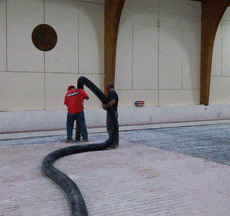Debris Removal with Hydro Excavation
 Debris removal is the process of hauling away landscaping
Debris removal is the process of hauling away landscaping
and construction debris. Hydro Excavation is suggested for sites where grinding or burning is not applicable to get rid of debris. The places that typically need debris removal are construction and demolition sites, areas of vegetation accumulation, and areas where concrete and asphalt need to be hauled away.
The precision and accuracy of the hydro excavation process can remove debris without any destruction caused to the surrounding area. Also, since most construction sites are already hazardous to begin with, hydro excavation does not add to that.
Backhoes were commonly used in debris removal before hydro excavation was developed. This heavy machinery used a large digging bucket mounted on a tractor to excavate and haul away debris. This method has the possibility of damaging the environment. Also, if the equipment malfunctions, accidents may occur and injure the laborers.
With the use of a combination of highly pressurized water and a vacuum, hydro excavation can clear out structures and areas of debris. The pressurized water is blasted into the ground through the use of a handheld device. The slurry is then vacuumed from the away from the site by a debris hose and is transferred to a large debris tank.
Using hydro excavation for removing debris gives you a lower possibility of damaging the surrounding area. The hydro excavation process is able to do that because of the precision and accuracy that it provides. It is a totally non-destructive and non-mechanical process.
This new process of digging also lessens traffic and congestion in the site because the bulk of the equipment that is needed can be positioned away from the actual work site. This will allow for more work space and creates a less cluttered area to work in.
You can find reliable hydro excavation companies near you by entering your zip code in our search bar to the left.
More about Hydro Excavation
Hydro excavation is a digging method that involves water and air. The water used is highly pressurized so it can break through soil. Once the digging is done, the soil is transferred to a debris tank through an air vacuum. This process does not involve any heavy equipment and the pressurized water is able to do a more accurate job.
Backhoes and manual digging have been traditional ways of excavating soil. These processes involved higher costs and longer times to finish an excavation. Backhoes are very heavy equipment and they bring safety risks to the people involved. Manual digging or hand dogging is a very intensive job for the laborers. These conventional processes often require restoration of the site after the job is complete which means additional labor and material costs.
Hydro excavation is a very accurate process. It does not damage soil or the surrounding area unnecessarily so there would be no need for restoration. This means that additional restoration time and costs are eliminated. The hydro excavation equipment is not hard to operate and handle so this method is easier on the laborers too.
